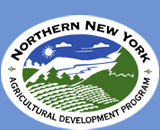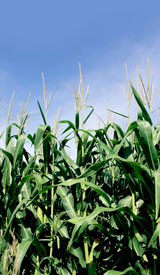July 22, 2009
Contact: Cornell Cooperative Extension: Clinton County: 518-561-7450;
Essex County: 518-962-4810 x409; Franklin County: 518-483-7403;
Jefferson County: 315-788-8450; Lewis County: 315-376-5270; St. Lawrence
County: 315-379-9192
Research Shows Still Time to Increase Hay Yields
In spite of rainy weather in some parts of Northern New York, farmers
still have time to increase hay and haylage yields, say Cornell
Cooperative Extension educators.
“Simply top dressing hay fields right after cutting with nitrogen –
either through manure or fertilizer – can produce double the yield and
improve the quality of the next cutting,” says Field Crops Educator
Michael E. Hunter with Cornell Cooperative Extension (CCE) of Jefferson
County. “We have seen a two-to-three to one return on this practice.”
“Improving your forage quality means cows will eat more with less waste
and that shows results in increased milk production,” says CCE Jefferson
County Dairy and Livestock Educator Ron Kuck.
Hunter has assisted field crop trials and written about intensive grass
crop management.
At Doubledale Farm in Ellisburg, NY, Dan and Sharon Rossiter
participated in an on-farm trial to determine the optimium rate for
applying nitrogen to an intensively-managed orchardgrass hay crop in
2005.
“We harvested four cuttings of high quality orchardgrass hay that year.
We compared applying urea (approximately 70 lbs/acre of actual N
applied) between cuttings to not applying any nitrogen fertilizer and
saw a 100 percent first cutting yield increase on the field with the
urea applied,” Dan says.
The 50 lbs/acre of actual N applied field resulted in a 197 percent
increase for second cutting, a 93 percent increase for third cutting,
and a 91 percent increase for fourth cutting.
“We gained 118 percent more dry matter by the end of the season,” Dan
says, “and while the expense of fertilizer application may seem high,
when you consider the increased yield return, I considered the money
spent on fertilizer well spent in 2005 and we are still practicing this
type of hay management.”
Hunter says “For more information on fertilizing hay crops to gain yield
you can refer to Extension publications that are 40 years old. This is a
tried and true practice that farmers sometimes do not use because of the
cost of fertilizer, but weigh cost against yield and it could be a
practice worth adding to your forage management plan.”
Hay and grass crop management resources can be found at Cornell
Cooperative Extension offices and on the Northern New York Agricultural
Development Program website at www.nnyagdev.org. #



